2009 AUDI S4 CABRIOLET warning
[x] Cancel search: warningPage 228 of 340

-Tr
aile r t owing ---=--------------
W eig ht dis tri buti on
Towing a loaded trailer with an empty car resu lts in a high ly
unstable distribution of weight . If this cannot be avoided drive at
ve ry low speeds only to avoid the risk of los ing steering control.
A "ba lanced" rig is easier to operate and control. This means that
the tow vehicle should be loaded to the extent possible and permis
sib le whi le keeping the trailer as light as possib le under the circum
stances. Whenever possible, transfer some cargo to the luggage
compartment of the tow vehicle while observing tongue load
requirements and vehicle loading considerations .
Speed
The higher the speed, the more difficult it becomes for the driver to
contro l the rig . Do not drive at the maximum permissible speed.
Reduce your speed even more under unfavorable load, weather or
wind condi tions -particularly when going downhill.
Reduce vehicle speed
imm ed iately if the trailer shows the slightest
sign of swaying.
Do not try to stop the s waying by a ccelerating .
Observe speed limits. In some areas speeds for vehic les towing
trai lers are lower than for regular vehicles.
Always app ly brakes early. When driving downhill, shift into lower
gear to use the engine braking effect to slow down the vehicle. Use
of the brakes alone can cause them to overheat and fail.
C oo lan t tem pe ra ture
The coolant temperature gauge~ page 73 must be observed care
fully. If the needle moves close to the upper end of the scale, reduce
speed immediately and/or switch off the air conditioner.
If the coolant temperature warning light in the instrument cluster
starts flashing -~- , pul l off the road, stop and let the engine
idle for
about two minutes to prevent heat build -up .
& WARNING
An yone not prop erl y r estr ained in a mo ving ve hic le is at a much
gre ater ri sk in an accident. N ever let an yone rid e in your car who
is not p roperl y wearing the r estraint s pro vid ed by Audi.
c
Trailer towing tips
Important to know
Your vehicle handles differently when towing a trai ler because of
the additional weight and weight distribution . Safety, performance
and economy will great ly depend on how carefu lly you load your
trai ler and operate your rig.
Before you actually tow your trailer, practice turn ing, stopping and
backing up in an area away from traffic. Keep practicing unti l you
have comp letely become familiar with the way your vehicle -trailer
combination behaves and responds .
Backing up is difficu lt and requires practice. Backing up with a
trailer genera lly requires s teering action opposite of that when
backing up your vehic le without a trailer.
Maintain a greater distance between you r vehicle and the one in
front of you. You will need more room to stop.
To compensate for the trailer, you wi ll need a larger than normal
turning radius .
When passing, remember that you cannot accelerate as fast as you nor mally wou ld because of the added load . Make sure yo u have
enough room to pass. After passing, allow plenty of room for your
trai ler before changing lanes again .
Avo id jerky starts, sharp turns o r rapid lane changes.
Page 232 of 340
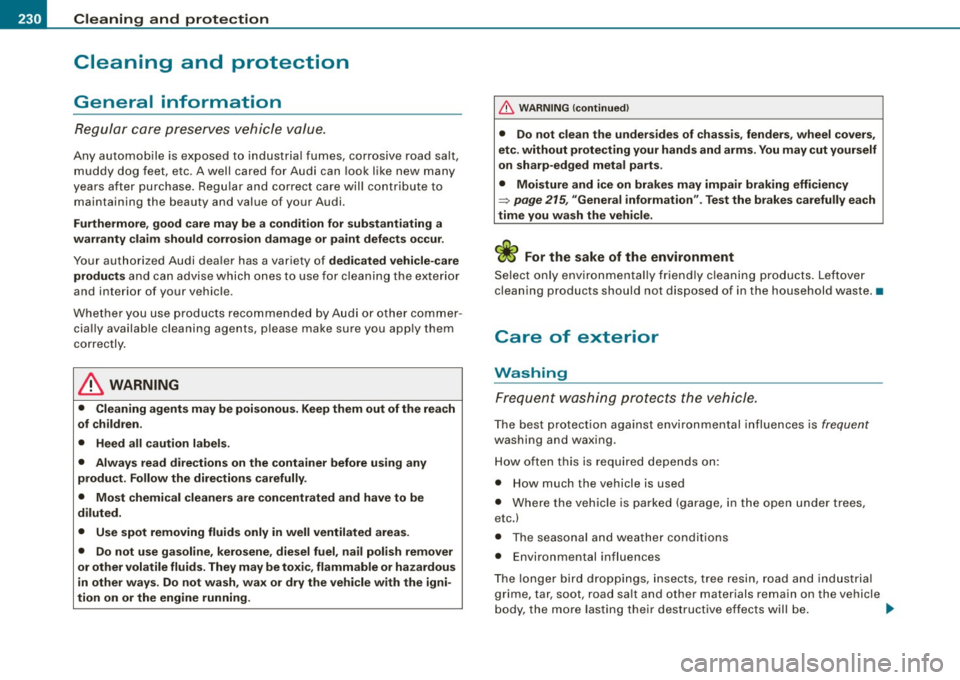
___ C _l_e _a _ n_ in_g ~_ a_n _ d ____ p ____ r_ o _t _e _c_ t_ i_o _n _____________________________________________ _
Cleaning and protection
General information
Regular care preserves vehicle value.
Any automob ile is exposed to industria l fumes, corrosive road salt,
muddy dog feet, etc . A well cared for Audi can look like new many
yea rs a fter purchase. Regu lar and correct care wil l co ntribut e to
maintaining the beauty and value of your Audi.
Furthermore , good care may be a condition for substantiating a
warranty claim should co rros ion damage or paint defect s occur .
Your authorized Audi dea ler has a variety of dedi cated vehicle- care
product s
and can advise which ones to use for cleani ng the exterio r
and interior of your vehicle.
Whethe r you use products recom mended by A udi or other co mmer
cially availab le cleaning agents, please make sure you app ly them
correctly.
& WARNING
• Cleaning agents may be poisonous. Keep them out of the reach
of children .
• Heed all caution label s.
• Always read directions on the container before u sing any
p roduct. Follow the direction s carefully .
• Most chemical cleaners are concentrated and have to be
d iluted.
• Use spot removing fluids only in well ventilated areas .
• Do not use gasoline , kerosene , die sel fuel , na il polish remo ver
or other volatile fluids . They may be toxic, flammab le or hazardous
in other way s. Do not wash , wax or dry the vehicle with the igni
tion on or the eng ine running.
& WA RNIN G (continued )
• Do not clean the unde rsides of chassis , fenders , wheel cover s,
etc . without protecting your hands and arms. You may cut yourself
on sh arp -edged metal part s.
• Moisture and ice on brake s may impair braking eff iciency
=> page 215 , "General info rmation ". Test the brakes ca refully each
time you wash the vehicle.
cleaning products should not disposed of in the household waste. •
Care of exterior
Washing
Frequent washing pro tects the vehi cle.
The bes t protection aga inst envi ron mental influences is frequent
washing and waxing .
Ho w o ften t his is required depends on:
• How much the vehicle is used
• Where the vehic le is parked (garage, in the ope n under t rees,
etc.)
• The sea so nal and wea the r condi tions
• Environmental influences
The longe r bir d droppings, i nsects, tree resin, road and indust ria l
grime, tar, soot, road salt and other materials remain on the vehicle
b ody, the mo re las ting thei r des tructive effects will be . _,,,
Page 233 of 340

Cleaning and protection -
----------------
•
High temperatures, as from exposure to intense sunlight, intensify
the corrosive effect particularly when humidity is high as well.
Under certain circumstances,
weekly washing may be necessary.
Under other conditions, a monthly washing and waxing may be
adequate.
After the winter, the
underside of the vehicle should be thoroughly
washed preferably in a professional car wash.
& WARNING
Always read and heed all WARNINGS and the information
~ page 230. •
Automatic car wash
The vehicle can be washed in almost any modern auto
matic car wash.
The vehicle paint is so durable that the vehicle can normally be
washed without problems in an automatic car wash. However, the
effect on the paint depends to a large extent on the design of the
facility, the filtering of the wash water, the type of wash and care
material , etc. If the paint has a dull appearance after going through
the car wash or is scratched, bring this to the attention of the oper
ator immediately . If necessary, use a different car wash .
The power top does not require specia l precautions before passing
through a car wash.
However, the car must not be treated with hot
wax after the wash cycle!
The wax could adversely affect the power
top and even damage the fabric over a period of time.
The power top does not have to be washed every time you use a car
wash . The power top can be spared if the car wash facility is
equipped with manually adjustable roof brushes or rollers.
Before going through a car wash, be sure to take the usual precau
tions such as closing the windows and power top. The factory-fitted antennas for the radio, car phone and navigation system* are all
located inside the vehicle interior.
If you have installed additional accessories on the vehicle
-such as
spoilers, etc. -it is best to ask the car wash operator if these should
be removed.
& WARNING
Always read and heed all WARNINGS and the information
~ page 230. •
Washing the vehicle by hand
A lot of water is needed when washing a vehicle by hand.
- Before you start washing, make sure you have read and
understood the WARNINGS=>
& in "General informa
tion" on page 230.
- First soak all dried dirt until it is soft, then rinse it off.
- As you clean your vehicle, start with the roof and work
your way down to the bottom, using a sponge, a sponge
glove or a clean brush.
- Rinse the sponge or the sponge glove often, flushing it
clean each time.
- Use special car shampoo only for very persistent dirt.
- Rinse the car thoroughly with water.
- Use a chamois leather to gently wipe the exterior dry.
Use a separate sponge for cleaning the wheels, door sills and other
regions exposed to road dirt. In this way, you wil l not scratch the
paint with coarse particles imbedded in the sponge the next time
you wash the car. ..,.
Vehic le care
Page 234 of 340
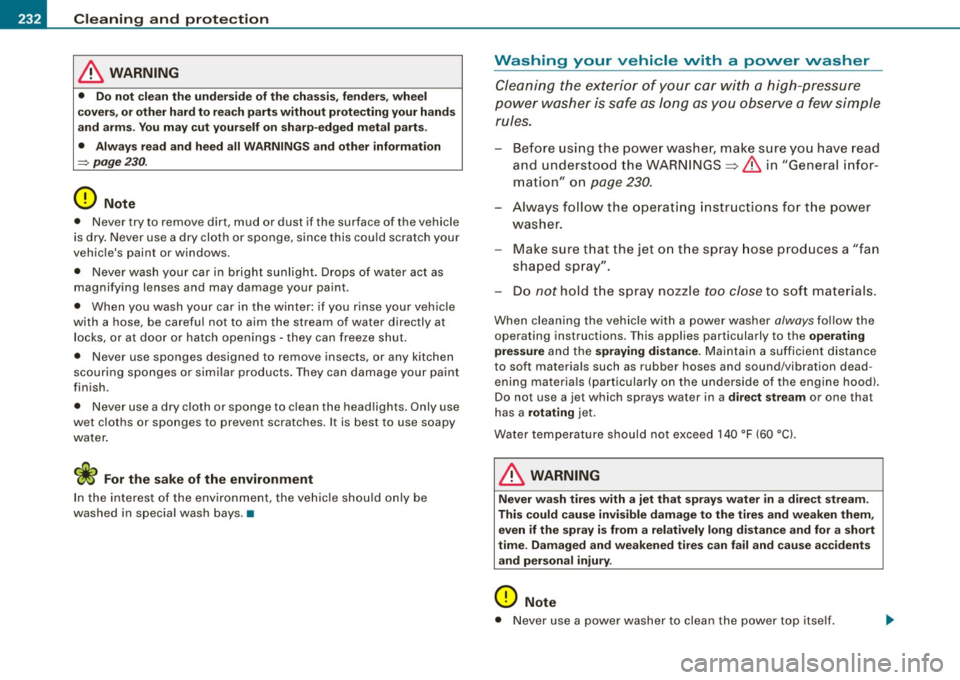
-Cleaning and protection P':ft':I _______________ _
& WARNING
• Do not clean the underside of the chassis, fenders, wheel
covers, or other hard to reach parts without protecting your hands
and arms. You may cut yourself on sharp-edged metal parts.
• Always read and heed all WARNINGS and other information
~ page 230.
0 Note
• Never try to remove dirt, mud or dust if the surface of the vehicle
is dry. Never use a dry cloth or sponge, since this could scratch your
vehicle's paint or windows.
• Never wash your car in bright sunlight. Drops of water act as
magnifying lenses and may damage your paint .
• When you wash your car in the winter: if you rinse your vehicle
with a hose, be careful not to aim the stream of water directly at
locks, or at door or hatch openings - they can freeze shut.
• Never use sponges designed to remove insects, or any kitchen
scouring sponges or similar products. They can damage your paint
finish .
• Never use a dry cloth or sponge to clean the headlights. Only use
wet cloths or sponges to prevent scratches . It is best to use soapy
water.
<£> For the sake of the environment
In the interest of the environment, the vehicle should only be
washed in special wash bays. •
Washing your vehicle with a power washer
Cleaning the exterior of your car with a high-pressure
power washer is safe as long as you observe a few simple
rules.
- Before using the power washer, make sure you have read
and understood the WARNINGS~
& in "General infor
mation" on
page 230.
Always follow the operating instructions for the power
washer.
Make sure that the jet on the spray hose produces a "fan
shaped spray".
Do
not hold the spray nozzle too close to soft materials.
When cleaning the vehicle with a power washer always follow the
operating instructions. This applies particularly to the
operating
pressure and the spraying distance. Maintain a sufficient distance
to soft materials such as rubber hoses and sound/vibration dead ening materials {particularly on the underside of the engine hood).
Do not use a jet which sprays water in a
direct stream or one that
has a
rotating jet.
Water temperature should not exceed 140
°F (60 °C).
& WARNING
Never wash tires with a jet that sprays water in a direct stream.
This could cause invisible damage to the tires and weaken them,
even if the spray is from a relatively long distance and for a short
time . Damaged and weakened tires can fail and cause accidents
and personal injury.
0 Note
• Never use a power washer to clean the power top itself.
Page 235 of 340
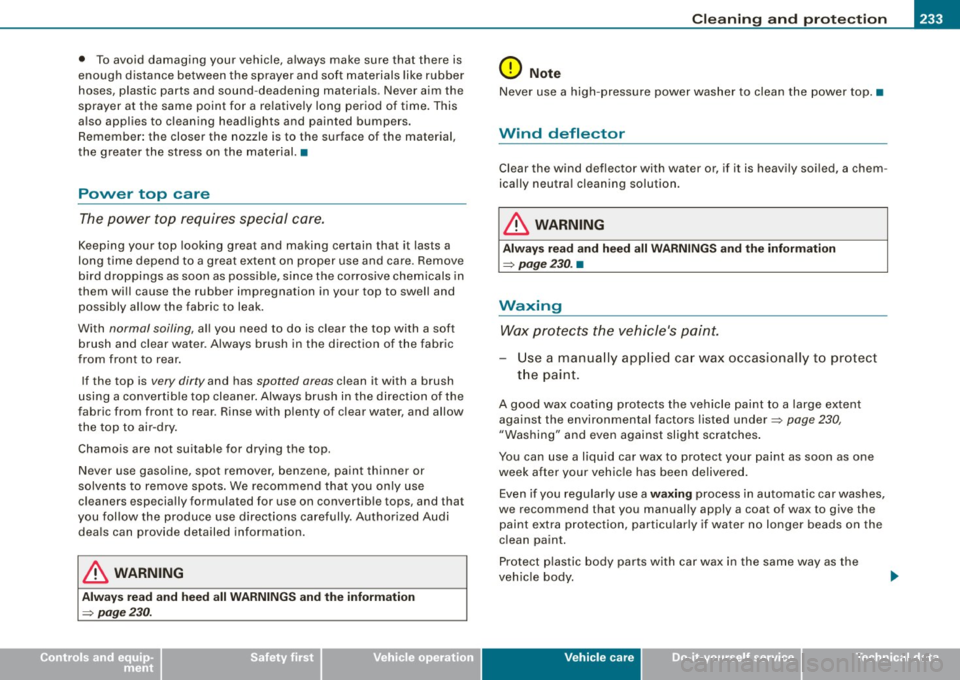
Cleaning and protection -
----------------
•
• To avoid damaging your vehicle, always make sure that there is
enough d istance between the sprayer and sof t materials like rubber
hoses, plastic parts and sound -deadening materials . Never aim the
sprayer at the same point for a re latively long period of t ime. This
also applies to cleaning headlights and painted bumpers. Remember : the closer the nozzle is to the surface of the material,
the greater the stress on the material. •
Power top care
The power to p requires s pecial c are.
Keeping your top look ing great and making certain that it lasts a
long time depend to a great extent on proper use and care. Remove
bird droppings as soon as possib le, since the corrosive chemicals in
them wi ll cause the rubber impregnation in your top to swell and
possibly allow the fabric to leak.
With normal soiling, all you need to do is c lear the top with a soft
brush and clear water. Always brush in the direction of the fabric
from front to rear.
If the top is very dirty and has spotted areas clean it with a brush
using a convert ib le top cleaner . Always brush in the direction of the
fabric from front to rear . R inse with plenty of clear water, and allow
t he t op to air-dry .
Chamois are not suitab le for drying the top.
Never use gasoline, spot remover, benzene, paint thinner or
solve nts to remove spots . We recommend that you only use
cleaners especia lly formulated for use on convertib le tops , and that
you fol low the produce use d irections carefully. Authorized Audi
dea ls can provide detailed information.
& WARNING
Always read and h eed all WARNINGS and the information
=> page 2 30 .
0 Note
Never use a high -pressure power was her to clean the power top. •
Wind deflector
Clear the wind deflector with water or, if it is heavily soi led, a chem
ica lly neutra l cleaning solution .
& WARNING
Always read and heed all WARNINGS and the information
=> page 2 30 . •
Waxing
W ax pr otects the vehicle's p ain t.
- U se a manua lly ap plied ca r wa x occasi onall y to p ro tect
t h e paint.
A good wax coat ing protects the vehicle paint to a large extent
against the environmental factors listed under=> page 230,
"Washing" and even against slight scratches .
You can use a liquid car wax to protect your paint as soon as one
week after your vehic le has been delivered.
Even if you regular ly use a
waxing process in automa tic car was hes,
we recommend that you manual ly apply a coat of wax to give the
paint ex tra p rotecti on, particular ly if wa ter n o longer beads on the
c lean paint.
Protect plastic body parts with car wax in the same way as the
vehic le body.
Ve hic le care
Page 236 of 340
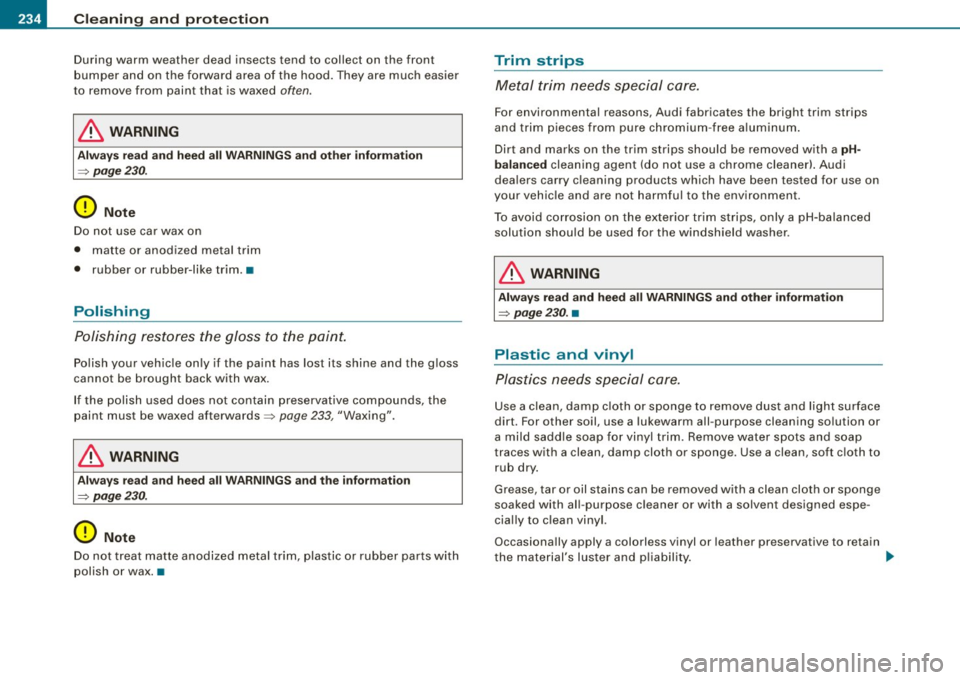
___ C_ le_ a _ n_i_n ~g _ a_ n_ d __ p_r _o _t _e _c_ t_ i_o _n ___________________________________________ _
During warm weather dead insects tend to collect on the front
bumper an d on the f orwar d area of the hood . They are much easier
to remove from paint that is waxed
often .
& WARNING
Alway s read and heed all WARNINGS and other informat ion
=> page 2 30.
0 Note
Do not use ca r wax on
• matte or anodized metal trim
• rubber or rubber -like trim. •
Polishing
Po lis hin g restores t he gloss to the pa int.
Po lish your vehicle on ly if the paint has lost its shine and the g loss
cannot be brought back with wax.
I f the p olish used does not contain preservative c ompounds, th e
paint must be waxed afterwards=>
page 233, "Waxing".
& WARNING
Always read and heed all WARNINGS and the inform ation
=> page 23 0.
0 Note
Do not treat matte anodized metal tr im, plastic or rubber parts with
polish or wa x.•
Trim strips
Metal tri m nee ds speci al care.
For environmental reasons , Audi fabricates the bright trim strips
and trim pieces from pure chr omi um -free a luminum .
Dirt and marks on the trim strips should be removed w ith a
pH
balan ced
cleaning agent (do not use a chrome cleaner). Audi
dea lers carry c leaning products which have been tested for use on
your vehicle and are not harmful to the environment.
To avoid co rrosion on the exterior trim strips, only a p H-ba lanced
solu tion should be used for the windshield washer .
& WARNING
Always read and heed all WARNINGS and other inform ation
=> page 2 30 . •
Plastic and vinyl
Plas tics needs spe cial care.
Use a clean , da mp c loth or sponge to remove dust and light surface
dirt. For other soil, use a lukewarm all -purpose cleaning so lution or
a mild sadd le soap fo r vinyl trim. Re move water sp ots and s oap
traces with a clean, damp cloth or sponge. Use a clean, soft c loth to
r ub dry .
Grease , tar or oil stains can be removed with a clean cloth or sponge
soaked with al l- purpose cleaner or with a solvent designed espe
cia lly to c lean vinyl.
Occas iona lly apply a colorless vinyl or leather preservative to retain
t he material's luster a nd p liabili ty. .,
Page 237 of 340
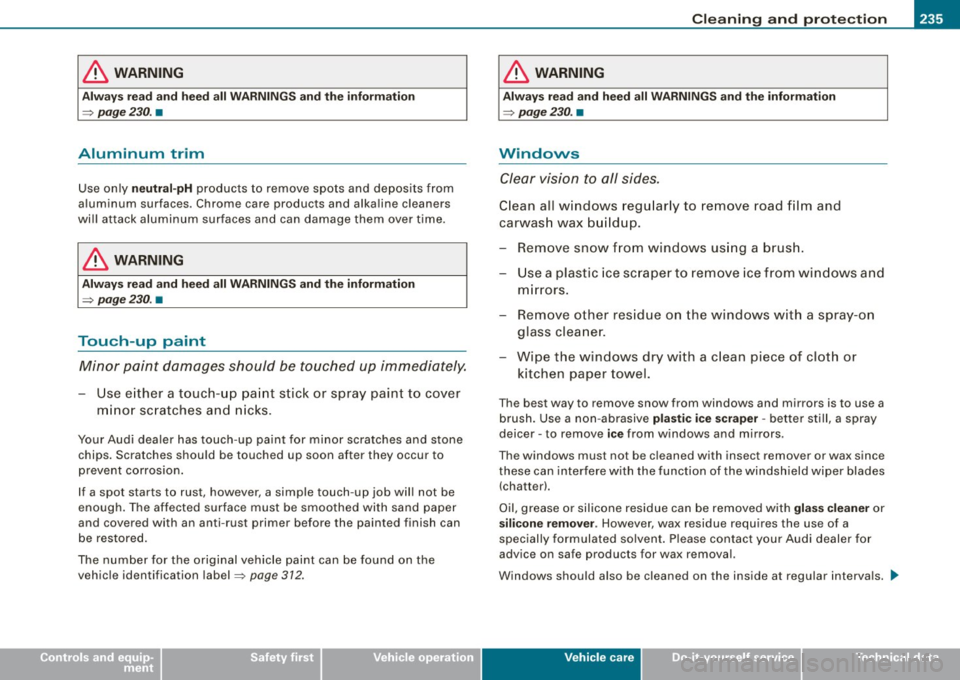
Cleaning and protection -
----------------
•
& WARNING
Always read and heed all WARNINGS and the information
~ page 230. •
Aluminum trim
Use only neutral-pH products to remove spots and deposits from
aluminum surfaces. Chrome care products and alkaline cleaners
will attack aluminum surfaces and can damage them over time.
& WARNING
Always read and heed all WARNINGS and the information
~ page 230 . •
Touch-up paint
Minor paint damages should be touched up immediately.
-Use either a touch-up paint stick or spray paint to cover
minor scratches and nicks.
Your Audi dealer has touch-up paint for minor scratches and stone
chips. Scratches should be touched up soon after they occur to
prevent corrosion.
If a spot starts to rust, however, a simple touch-up job will not be
enough. The affected surface must be smoothed with sand paper
and covered with an anti-rust primer before the painted finish can
be restored.
The number for the original vehicle paint can be found on the
vehicle identification label~
page 312 .
& WARNING
Always read and heed all WARNINGS and the information
~ page230. •
Windows
Clear vision to all sides.
Clean all windows regularly to remove road film and
carwash wax buildup.
Remove snow from windows using a brush.
- Use a plastic ice scraper to remove ice from windows and
mirrors.
- Remove other residue on the windows with a spray-on
glass cleaner.
Wipe the windows dry with a clean piece of cloth or kitchen paper towel.
The best way to remove snow from windows and mirrors is to use a brush. Use a non -abrasive
plastic ice scraper -better still, a spray
deicer -to remove
ice from windows and mirrors .
The windows must not be cleaned with insect remover or wax since
these can interfere with the function of the windshield wiper blades (chatter!.
Oil, grease or silicone residue can be removed with
glass cleaner or
silicone remover . However, wax residue requires the use of a
specially formulated solvent. Please contact your Audi dealer for
advice on safe products for wax removal.
Windows should also be cleaned on the inside at regular intervals. _,.
Vehic le care
Page 238 of 340
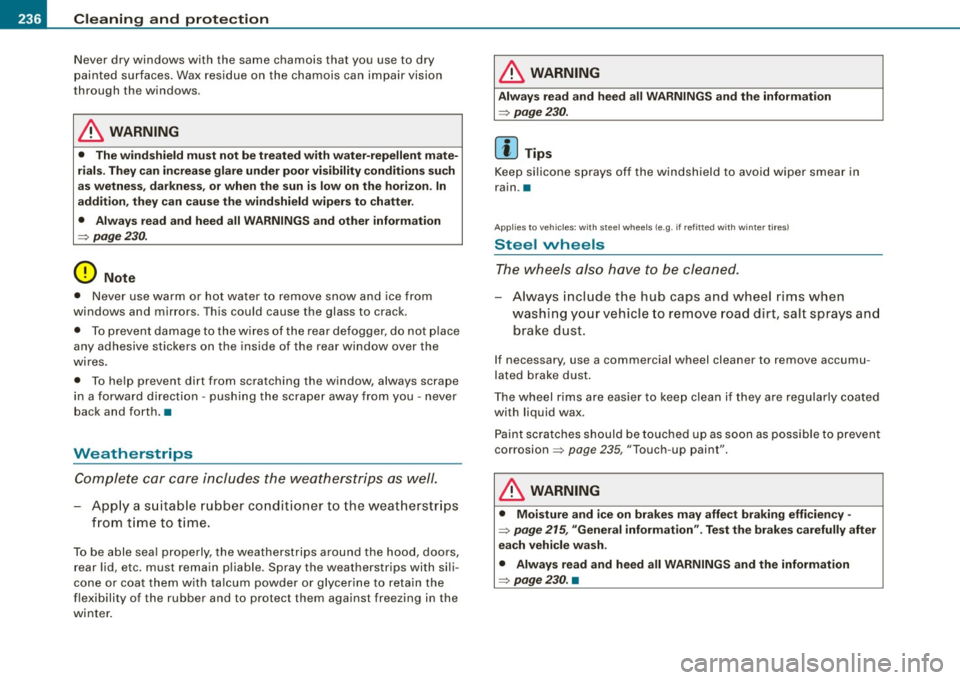
___ C_ le_ a _ n_i_n ~g _ a_ n_ d __ p_r _o _t _e _c_ t_ i_o _n ___________________________________________ _
Never dry windows with the same chamois that you use to dry
painted surfaces. Wa x resi due on the cha mois can impair vision
through the windows .
& WARNING
• The windshield must not be treated with water-repellent mate
rials. They can increase glare under poor visibility conditions such
a s wetne ss, darkness , or when the sun is low o n the horizon . In
addition , they can cause the wind shield wipers to chatter .
• Always read and heed all WARNINGS and other informat ion
~ page 2 30.
0 Note
• Never use war m or hot wa ter to remove snow and ice from
windows and mirrors. Th is could cause the glass to crack.
• To prevent damage to the w ires of the rear defogger, do not p lace
any adhesive stic kers on the inside of the rear window over the
wires.
• To he lp prevent dirt from sc ratching the w indow, a lways scrape
in a forward direction -pushing t he scraper away from you -nev er
back and forth. •
Weatherstrips
Complete c ar ca re includes the wea the rs trips as well .
- App ly a s uitable rubber co ndit ioner to the weat herstr ips
f rom t ime to t ime.
To be able sea l properly, the weatherstrips around the hood, doors,
rear lid , etc. must remain pliable . Spray the weatherstrips with si li
co ne or coat them w ith ta lcum powder or glycer ine to retain the
flexibility of the rubber and to protect them against free zing in the
winter .
& WARNING
Always read and heed all WARNINGS and the infor mation
~ page 2 30 .
[ i ] Tips
K eep si lico ne s prays off the windsh ield to avo id wiper smear in
rain .•
Ap plies to vehic les : w it h s teel whee ls te.g. if ref itt ed with winte r tiresl
Steel wheels
The wheels also have to be cle aned.
Always include the hub caps and wheel rims when
washing yo ur vehicle to remove roa d dirt, sal t sprays and
brake dust.
I f necessary, use a commercial wheel cleaner to remove accumu
la ted brake dust.
The wheel rims a re eas ier to kee p clean i f they are regular ly coated
with liquid wax .
Paint scratches sh ou ld be touc hed u p as so on as possible to p reven t
corrosion~
page 235, "Touch -up paint".
& WARNING
• Moisture and i ce on brakes may affect br aking efficiency -
~ page 215, "General information ". Test the brakes carefully after
ea ch vehicle wa sh .
• Alway s read and heed all WARNINGS and the information
~ page230. •